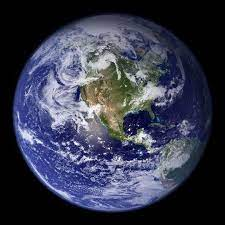Earth
(4.5 Billion years ago)
Earth and the other planets formed about 4.6 billion years ago. They were made of the leftover gas from the nebula that made the Sun. The Moon may have been formed after a collision between the early Earth and a smaller planet (sometimes called Theia). Scientists believe that parts of both planets broke off - becoming (by gravity) the Moon.
Earth's water came from different places. Condensing water vapor, and comets and asteroids hitting Earth, made the oceans. Within a billion years (that is about 3.6 billion years ago) the first life evolved, in the Archaean era. Some bacteria developed photosynthesis, which lets plants make food from the Sun's light and water. This released a lot of oxygen, which was first taken up by iron in the solution. Eventually, free oxygen got into the atmosphere or air, making Earth's surface suitable for aerobic life (see Great Oxygenation Event). This oxygen also formed the ozone layer which protects Earth's surface from bad ultraviolet radiation from the Sun. Complex life on the surface of the land did not exist before the ozone layer.Earth was very different in the distant past. Long ago, almost all land was in one place. This is called a supercontinent. The earliest known supercontinent was called Vaalbara. Much later, there was a time (the Cryogenian) when Earth was almost entirely covered by thick ice sheets (glaciers). This is called the Snowball Earth theory.



Comments
Post a Comment